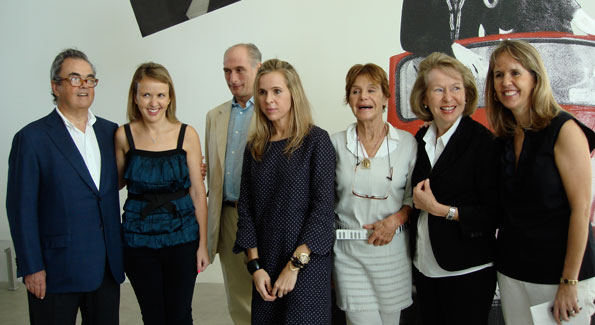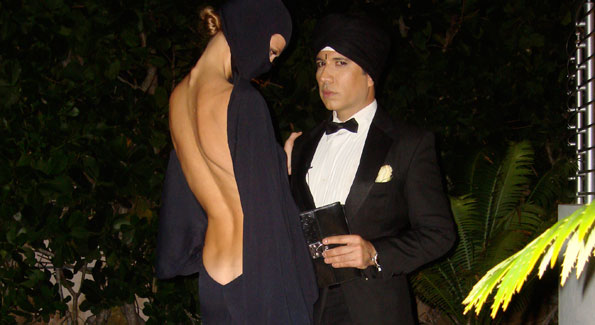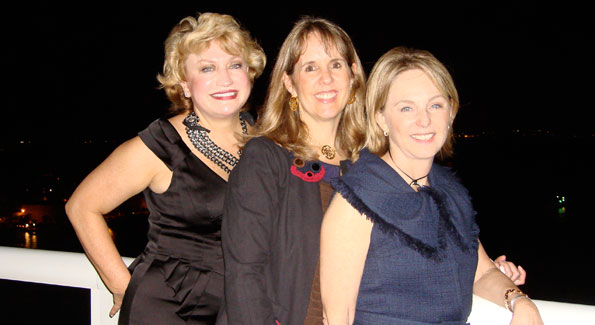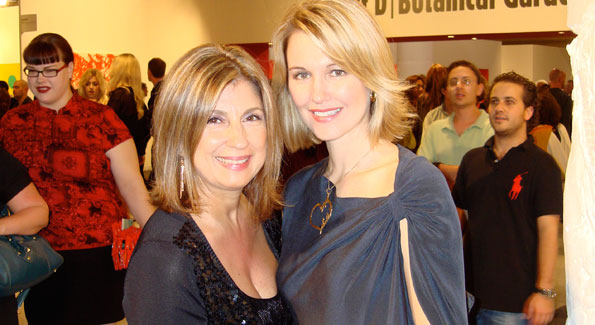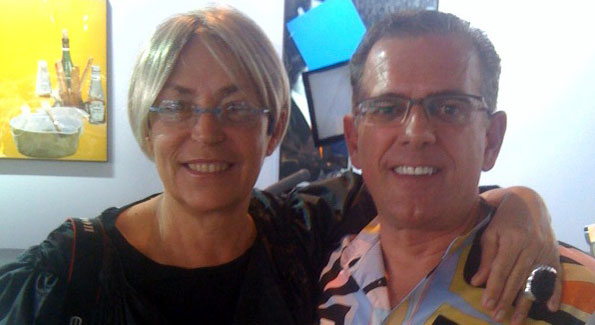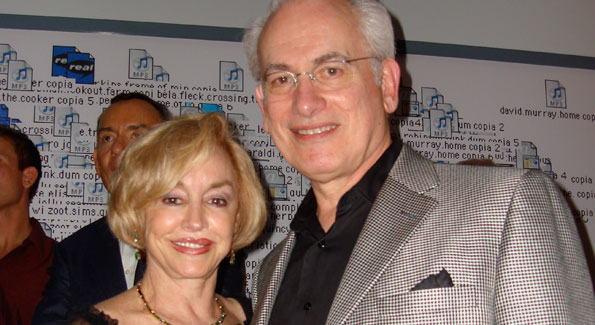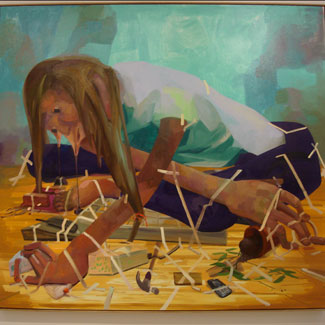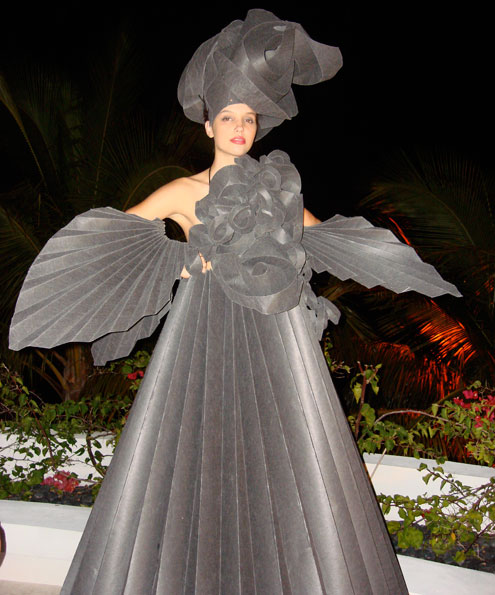Day One: It’s All About Design
The week began not with art but with the art of design—the other collecting frontier—at the collectors preview and Vernissage of Design Miami, the design satellite of Art Basel. Since 1954, the Archives of American Art has actively collected the papers and primary records of the nation’s top designers and architects, and this year it supported the fair as a Museum Partner. Russian collector Vladislav Doronin and girlfriend Naomi Campbell stopped by the booth of French dealer Patrick Seguin featuring an exhibition of three prefabricated projects by Jean Prouvé, while Washington collectors Conrad and Ludmila Cafritz and Fred Ognibene visited the special installation by Designer of the Year Maarteen Baas, a series of video-based clocks that told time through the movement of hundreds of actors on film. The large temporary structure designed by the New York studio Aranda\Lasch revealed a Swarovski Crystal Palace of billowing 7-foot sails suspending 1.5 million crystals, a wood workshop, and an array of limited-edition, experimental design objects including a walking table and vessels made out of animal bones found on the banks of the river Thames. The energy on opening night was high, like the music of the L.A. band OK Go performing live on fur-clad guitars sprouting laser beams in shades of neon.
Day Two: Art Rules
The day began with a private tour of the headquarters of DACRA, the global real estate development company that re-imagined and revitalized the city’s bustling new Design District. CEO Craig Robins, an avid collector and financier of Design Miami, welcomed our group in front of one of forty John Baldessari artworks he owns in a private collection of 1,000 pieces. Michael Pollack commented “How can they get any work done among such beautiful art,” a predicament that as a museum employee I’ve come to know all too well.
Next stop, the most anticipated of all openings, the collector’s preview of Art Basel Miami Beach. Though it was reported that crowds were much smaller this year, the traffic jam of bodies—from celebrities and bodyguards to collectors and museum directors—in the Miami Beach Convention Center on VIP day indicated otherwise, even with the new redesign boosting larger isles and spaces for the 250 galleries exhibiting 20th and 21st century works by over 2,000 artists. Michael Jackson made several posthumous appearances, including in an immense equestrian portrait by Kehinde Wiley at the Deitch Projects, and so did the neon of the previous night in drawings with text by Dan Attoe and Peter Liversidge that read: “We’re all here because we were too afraid to deal with problems in our real lives,” and “Miami Beach is where neon goes to die.” Perhaps. I spot Sylvester Stallone as I made my way into the VIP lounge where I connected with Washington Life stylist Lana Orloff and Fariba Jahanbani eyeing beautiful Cartier baubles.
A very Washington scene unfolded later at the annual Brillembourg-Ernst-Levinas reception at the Murano at Portofino, where hosts Arturo and Hilda Ochoa-Brillembourg, Isabel Ernst and Dani and Mirella Levinas mingled with art patrons including Jane and Calvin Cafritz, Gisela and Ben Huberman and MTV’s Mario Cader-Frech in a very warm atmosphere that involved live music from the Youth Orchestra of the Americas, a glorious ocean view, and a little art experiment that revealed Aniko Gaal Schott’s amazing talent and my complete lack thereof.
Day 3: Going Public
Although the art fairs are the main attraction, Miami’s awe inspiring private collections, many of them on view to the public, come in close second. Back in the Wynwood Design District, we made a quick stop at a home of collectors Lin Lougheed and Aaron Fleischman for a Cuban breakfast celebrating emerging Miami artists. After sipping coconut water and sugar-cane juice and hearing from arts patron Agnes Gund of her latest museum-quality acquisition, we made our way to Don and Mera Rubell’s public space, featuring a contemporary collection that rivals most museums.
Owners of the Capitol Skyline Hotel, the Rubells presented “Beg, Borrow and Steal,” an exhibition featuring 260 pieces from their collection by 74 artists who appropriated images from other artists as well as from popular media, such as Keith Haring’s version of Andy Warhol’s Marilyn and Elvis and Nate Lowman’s posters of violent images in the tabloids. Jerome Stern, whose ArtBarn I had visited with an Archives of American Art group in August, was impressed by the show, which also featured eatable art in a grid of doughnuts nailed to a backyard wall.
Nearby at the highly anticipated and stunning new three-story, 30,000 sq. ft. light-filled public space housing part of the Rosa and Carlos De La Cruz collection, daughter Isabel Ernst explained, as she greeted guests like dealer Paula Cooper, Bernard Picasso and Germana Ferrari Matta, that the venue will also serve as an educational center with an annual lecture series and a research library benefiting local art students.
The marathon continued at Art Miami, one of the largest satellite fairs, which I found this year to be both stunning and inspiring, and then to Red Dot, ending at the Miami Art Museum with D.C. artist and collector Andres Tremols for a tour of the exhibition “Guillermo Kuitca: Everything, Paintings and Works on Paper,1980-2008” followed by a reception organized by MAM in collaboration with the Hirshhorn Museum. And just when we thought we could not take in any more beauty, we close the day at the picture-perfect Sunset Island home of photography collectors Gert and Ulla Elfering for a pool and ocean-side night reception where art imitated fashion, and fashion imitated art.
Days Four and Five: Connecting the Dots
The next 48 hours were a race of stops and visits that made it abundantly clear to all involved that once again I had compiled an impossibly ambitious calendar, but one whose lack of adherence to I would have regretted for an entire year.
A highlight of the week for me and 200 or so other guests, forty of which were Archives members, was a private breakfast and viewing at the Key Biscayne home of Carlos and Rosa de la Cruz, where once again Washington faces abound. With the impeccable hospitality that is a trademark of this family, Isabel and her father Carlos took us around 15 rooms filled with contemporary art, each focusing on a particular artist. As we arrive on room 13, I stop dead in my tracks as seven Dana Schutz paintings, some of which I had seen in the exhibition “Eclipse” marking the fiftieth anniversary of Stockholm’s Moderna Museet in 2008, including my favorite of all, “Gravity Fanatic,” were now in front of me hanging at the walls of the De la Cruz residence.
Back in South Beach, we tour yet another massive private-turned-public collection at the Wolfsonian Museum, a gem in the heart of Miami Beach, and then meet developer Robert Wennett for a last-minute, hard-hat tour of his Herzog & de Meuron-designed masterpiece of a parking garage that features high end retail, dining, and residential space and is due to debut as 1111 Lincoln Road in 2010. As this visionary, responsible for the enhancement of diverse urban environments from New York’s Meat-Packing District to Washington’s Dupont Circle, Woodley Park, Cleveland Park, Chevy Chase/Friendship Heights, and Alexandria’s historic waterfront, explained how the landscaping was done with plants native to Miami and 8 million stones laid individually by hand, an Archives Trustee turns to me and says: “We should move our annual gala to this parking garage,” to which I replied: “not a bad idea!”
The next day, we bid farewell to some favorite spots including Design Miami, where we ran into Washington Kastles owner Mark Ein, and Photo Miami, and then off to a sunset cocktail at La Piaggia Restaurant celebrating “Exposed:10 years in Hollywood by Mark Liddell.” Finally, I meet Washington artist Mark Smith and his wife Lani Hay for a final dinner with friends at the Fontainebleau’s Blade Sushi Lounge.
For a week whose financial success expected to signal—or not—the end of the recession for the art world, Art Basel Miami Beach and its satellites provided an awesome range of cultural and social highlights and showed, with defiance, that the art market is rebounding, that collectors are indeed buying, and that the “art fair,” to our relief, is not endangered.
Carolina Furukrona is the Director of Development of the Smithsonian’s Archives of American Art, the world’s preeminent research center dedicated to collecting, preserving and making available for study the primary records that document the history of the visual arts in America.

